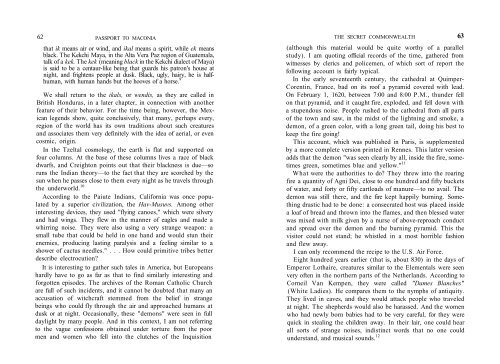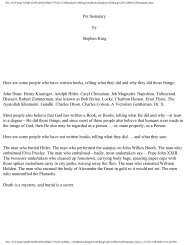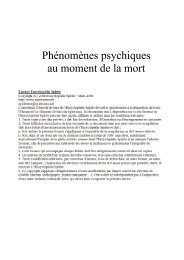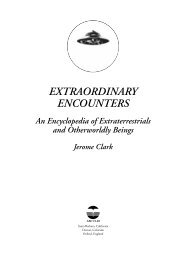Create successful ePaper yourself
Turn your PDF publications into a flip-book with our unique Google optimized e-Paper software.
62 PASSPORT TO MACONIA<br />
that ik means air or wind, and ikal means a spirit, while ek means<br />
black. The Kekchi Maya, in the Alta Vera Paz region of Guatemala,<br />
talk of a kek. The kek (meaning black in the Kekchi dialect of Maya)<br />
is said to be a centaur-like being that guards his patron's house at<br />
night, and frightens people at dusk. Black, ugly, hairy, he is halfhuman,<br />
with human hands but the hooves of a horse. 9<br />
We shall return to the ikals, or wendis, as they are called in<br />
British Honduras, in a later chapter, in connection with another<br />
feature of their behavior. For the time being, however, the Mexican<br />
legends show, quite conclusively, that many, perhaps every,<br />
region of the world has its own traditions about such creatures<br />
and associates them very definitely with the idea of aerial, or even<br />
cosmic, origin.<br />
In the Tzeltal cosmology, the earth is flat and supported on<br />
four columns. At the base of these columns lives a race of black<br />
dwarfs, and Creighton points out that their blackness is due—so<br />
runs the Indian theory—to the fact that they are scorched by the<br />
sun when he passes close to them every night as he travels through<br />
the underworld. 10<br />
According to the Paiute Indians, California was once populated<br />
by a superior civilization, the Hav-Musuvs. Among other<br />
interesting devices, they used "flying canoes," which were silvery<br />
and had wings. They flew in the manner of eagles and made a<br />
whirring noise. They were also using a very strange weapon: a<br />
small tube that could be held in one hand and would stun their<br />
enemies, producing lasting paralysis and a feeling similar to a<br />
shower of cactus needles." . . . How could primitive tribes better<br />
describe electrocution?<br />
It is interesting to gather such tales in America, but Europeans<br />
hardly have to go as far as that to find similarly interesting and<br />
forgotten episodes. The archives of the Roman Catholic Church<br />
are full of such incidents, and it cannot be doubted that many an<br />
accusation of witchcraft stemmed from the belief in strange<br />
beings who could fly through the air and approached humans at<br />
dusk or at night. Occasionally, these "demons" were seen in full<br />
daylight by many people. And in this context, I am not referring<br />
to the vague confessions obtained under torture from the poor<br />
men and women who fell into the clutches of the Inquisition<br />
THE SECRET COMMONWEALTH 63<br />
(although this material would be quite worthy of a parallel<br />
study). I am quoting official records of the time, gathered from<br />
witnesses by clerics and policemen, of which sort of report the<br />
following account is fairly typical.<br />
In the early seventeenth century, the cathedral at Quimper-<br />
Corentin, France, bad on its roof a pyramid covered with lead.<br />
On February 1, 1620, between 7:00 and 8:00 P.M., thunder fell<br />
on that pyramid, and it caught fire, exploded, and fell down with<br />
a stupendous noise. People rushed to the cathedral from all parts<br />
of the town and saw, in the midst of the lightning and smoke, a<br />
demon, of a green color, with a long green tail, doing his best to<br />
keep the fire going!<br />
This account, which was published in Paris, is supplemented<br />
by a more complete version printed in Rennes. This latter version<br />
adds that the demon "was seen clearly by all, inside the fire, sometimes<br />
green, sometimes blue and yellow." 11<br />
What were the authorities to do? They threw into the roaring<br />
fire a quantity of Agni Dei, close to one hundred and fifty buckets<br />
of water, and forty or fifty cartloads of manure—to no avail. The<br />
demon was still there, and the fire kept happily burning. Something<br />
drastic had to be done: a consecrated host was placed inside<br />
a loaf of bread and thrown into the flames, and then blessed water<br />
was mixed with milk given by a nurse of above-reproach conduct<br />
and spread over the demon and the burning pyramid. This the<br />
visitor could not stand; he whistled in a most horrible fashion<br />
and flew away.<br />
I can only recommend the recipe to the U.S. Air Force.<br />
Eight hundred years earlier (that is, about 830) in the days of<br />
Emperor Lothaire, creatures similar to the Elementals were seen<br />
very often in the northern parts of the Netherlands. According to<br />
Corneil Van Kempen, they were called "Dames Blanches"<br />
(White Ladies). He compares them to the nymphs of antiquity.<br />
They lived in caves, and they would attack people who traveled<br />
at night. The shepherds would also be harassed. And the women<br />
who had newly born babies had to be very careful, for they were<br />
quick in stealing the children away. In their lair, one could hear<br />
all sorts of strange noises, indistinct words that no one could<br />
understand, and musical sounds. 12





